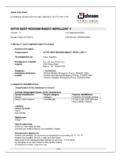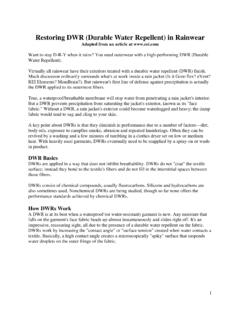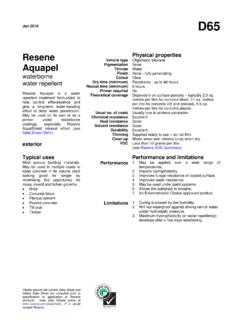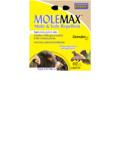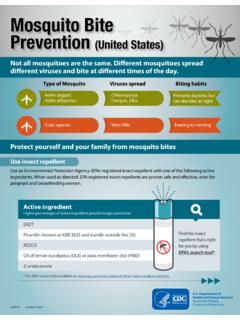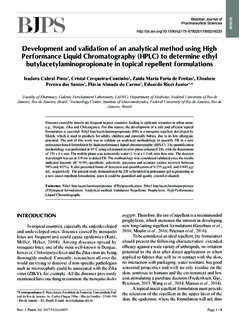Transcription of Repellent Fact Sheet 2015 - Connecticut
1 Prevention of Tick Bite and Tick-Borne Disease: Tick Checks and Use of Insect Repellents Kirby C. Stafford III The Connecticut Agricultural Experiment Station ( ) 1 fact Sheet 050100150200250300350400450500 MayJuneJulyAugSeptNymphs per ha The Prevention of Tick Bite and Tick-Borne Disease: Tick Checks and the Use of Insect Repellents Dr. Kirby C. Stafford III Department of Entomology/Center for Vector Biology and Zoonotic Diseases The Connecticut Agricultural Experiment Station The prevention of tick bites and the prompt detection and removal of attached ticks can reduce the chance of tick-associated diseases. The pathogens that cause Lyme disease, human babesiosis, human granulocytic anaplasmosis, a relapsing fever Borrelia, and Powassan virus ( , deer tick virus) are spread by the bite of the blacklegged tick, Ixodes scapularis (commonly called the deer tick).
2 The American dog tick, Dermacentor variabilis, can transmit the agents of Rocky Mountain spotted fever and tularemia, and can cause tick paralysis. The lone star tick, Amblyomma americanum, has long been considered mainly a nuisance pest and locally, the tick can be extremely abundant. This tick is the vector for three Ehrlichia agents, primarily Ehrlichia chaffeensis; has been associated with southern tick-associated rash illness (STARI) and a red meat allergy; is possibly a vector for spotted fever rickettsioses and tularemia; and is probably the vector for the Hartland and Bourbon viruses, new pathogens associated with severe febrile disease recently recognized from initial cases in Missouri and Kansas. All active stages (larva, nymph and adult) of the blacklegged tick and lone star tick will feed on people and pets.
3 Each stage of a tick feeds only once and slowly; requiring several days to ingest the blood meal. Most Lyme disease, babesiosis, and anaplasmosis cases are associated with the bite of the nymphal stage of I. scapularis. Nymphs are small (about the size of a pinhead), difficult to spot, and are active during the late spring and summer months when most people are outdoors (see graph of relative activity). Adults of I. scapularis are associated with fewer cases of Lyme disease. Adult female ticks are larger, easier to spot, and are active in the fall, warmer days in the winter, and in the spring when outdoor activity may be more limited. Male blacklegged ticks do not require a blood meal and are rarely found attached, but may be found crawling on the body. Blood engorged female I. scapularis may be confused in the spring with the American dog tick.
4 Only the adult stage of the American dog tick feeds on people and pets and adult ticks are active during the months from April through August. All the stages of A. americanum are active in the summer months. Prevention of Tick Bite and Tick-Borne Disease: Tick Checks and Use of Insect Repellents Kirby C. Stafford III The Connecticut Agricultural Experiment Station ( ) 2 Dress appropriately and check for ticks .. Ticks do not jump, fly or drop from trees, but grasp passing hosts from the leaf litter, tips of grass, etc. Most ticks are probably picked up on the lower legs and then crawl up the body seeking a place to feed. Adult I. scapularis will seek a host higher in the vegetation ( , shrub layer) as deer are the primary host.
5 Wear light-colored clothing with the pants tucked into socks. Repellents can substantially increase the level of protection. On returning home, remove and wash and dry the clothing. Many ticks can survive a warm or hot water wash, but cannot withstand 1 hour in a hot dryer. Carefully inspect the body and quickly remove any attached ticks (Above: an engorged nymphal I. scapularis with straight pin and a unfed and engorged female tick on dime to illustrate size). Tick bites are usually painless and, consequently, many people may be unaware that ticks are or have been attached. Also, carefully inspect children and pets. As an age group, children have a higher rate of reported Lyme disease than many adults. Ticks may attach anywhere on the body (Figure 3), but most are initially picked up on the lower extremities.
6 A case control study found that checking for ticks within 36 hours of time spent in the yard or bathing within 2 hours was protective against Lyme disease. Pets can bring ticks into the home, resulting in a tick bite without the person being outdoors. A tick bite does not necessarily mean a person will develop Lyme disease (see risk of transmission). Most cases of Lyme disease result from an undetected tick and about 75% of ticks are acquired in activities around the home. Proportion of Ixodes scapularis (Top) and Dermacentor variabilis (Bottom) submitted to the Connecticut Agricultural Experiment Station recovered from various regions of the body. While ticks were recovered anywhere on the body, the distribution of the blacklegged tick was more uniform, while most American dog ticks were removed from the head and neck region.
7 Remove ticks promptly .. Head & Neck Feet & Legs Chest, Shoulder & Back Waist, Abdomen & Groin Arm Head & Neck Feet & Legs Chest, Shoulder & Back Waist, Abdomen & Groin Arm Photos courtesy Pfizer Central Research Prevention of Tick Bite and Tick-Borne Disease: Tick Checks and Use of Insect Repellents Kirby C. Stafford III The Connecticut Agricultural Experiment Station ( ) 3 Use thin-tipped tweezers or forceps to grasp the tick as close to the skin surface as possible. Pull the tick straight upward (see illustration) with steady even pressure. This should remove the tick with the mouthparts intact. If the mouthparts break off, it will not affect the chance of getting Lyme disease. Disinfect the area; a topical antibiotic may also be applied.
8 Save the tick for identification and evidence of tick bite. A dead tick can be saved dry in a small sealable bag or vial, particularly if it is to be tested for several tick-borne pathogens by DNA techniques (if available). Note the site and date of the bite. Other methods of tick removal ( petroleum jelly to suffocate the tick) are not effective. Use of heat from matches to make the tick back out or gasoline or other chemicals are unacceptable. Watch for signs and symptoms of Lyme disease. Although an average of only 25% of the nymphs in Connecticut is infected with B. burgdorferi, this can vary from about 10-40% in any given year or location. Risk of The risk of transmission of B. burgdorferi from an infected feeding nymph of I. scapularis increases dramatically after 48 hours of attachment.
9 Early removal of an attached tick will reduce the chance of Lyme disease. During the first 24 hours of tick attachment, there is no transmission. By 48 hours of feeding, the transmission rate in one study was only and then by 72 hours the transmission rate increases to 75%. Transmission by an infected tick is almost 100% after 4 days and full engorgement. Studies on the prophylactic use of antibiotics upon a detected tick bite found that the risk of Lyme disease in the placebo groups was around 5% or less. It also takes at least 24 hours for the agents of babesiosis and anaplasmosis to be transmitted by the tick. By contrast, the Powassan virus can be transmitted in as little as 15 minutes after tick attachment. Topically Applied Insect Insect (and tick) repellents applied to skin and/or clothing can be broadly grouped as synthetic-chemical or botanical chemical-based compounds.
10 There are about 150 Repellent products registered with the Environmental Protection Agency (EPA) for use on human skin. The National Pesticide Information Center has an insect Repellent locator ( ). These are general guidelines as studies have shown that the response to various repellents varies between tick species and stages of the tick (or type of mosquito). The formulation can also influence efficacy and acceptance and use by the consumer. An ideal Repellent would provide complete protection for several hours under different environmental conditions, protect against all biting arthropods, be non-toxic, non-irritating, be harmless to clothing, be 020406080100024487296 Probability of transmission Hours tick attached Illustrations by Kirby Stafford Prevention of Tick Bite and Tick-Borne Disease: Tick Checks and Use of Insect Repellents Kirby C.










